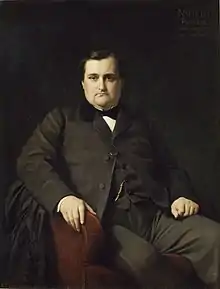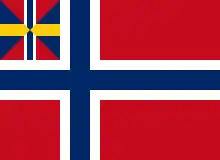Prince Napoléon Bonaparte
Napoléon Joseph Charles Paul Bonaparte[1] (9 September 1822 – 17 March 1891), usually called Napoléon-Jérôme Bonaparte or Jérôme Bonaparte, was the second son of Jerome, King of Westphalia, youngest brother of Napoleon I, and his second wife Catharina of Württemberg. An outspoken liberal,[2][3] he became the de facto head of the House of Bonaparte from 1879 to his death. He was not considered a legitimate pretender to the throne by many Bonapartists, due to his father's previous marriage without divorce. They instead preferred his son Victor.[4] From the 1880s he was one of the stronger supporters of General Georges Boulanger, together with other monarchist forces.[5]
Napoléon-Jérôme Bonaparte Prince Napoléon | |
|---|---|
 Portrait of Flandrin, 1860 (Musée d'Orsay) | |
| Minister of Algerian and Colonial Affairs | |
| In office 24 June 1858 – 24 March 1859 | |
| Monarch | Napoleon III |
| Preceded by | Ferdinand Hamelin |
| Succeeded by | Prosper de Chasseloup-Laubat |
| Member of the Chamber of Deputies | |
| In office 6 March 1876 – 28 October 1877 | |
| Constituency | Corsica |
| Member of the Senate | |
| In office 25 December 1852 – 4 September 1870 | |
| Member of the National Assembly | |
| In office 25 April 1848 – 2 December 1851 | |
| Constituency | Corsica (1848–49) Sarthe (1849–51) |
| Personal details | |
| Born | 9 September 1822 Trieste, Austria |
| Died | 17 March 1891 (aged 68) Rome, Italy |
| Resting place | Basilica of Superga, Turin |
| Political party | Bonapartist |
| Spouse(s) | |
| Children | Victor, Prince Napoléon Prince Louis Maria Letizia, Duchess of Aosta |
| Parents | Jerome, King of Westphalia and Catharina of Württemberg |
| Military service | |
| Allegiance | |
| Years of service | 1854–1855 |
| Rank | Major general |
| Battles/wars | Crimean War |
As well as bearing the title of Prince Napoléon, given him by his cousin Emperor Napoleon III in 1852,[6] he was also 3rd Prince of Montfort, 1st Count of Meudon and Count of Moncalieri, following his marriage with Maria Clotilde of Savoy in 1859. His popular nickname, Plon-Plon, stemmed from his difficulty in pronouncing his own name while still a child.
Biography
Born at Trieste in the Austrian Empire (today Italy), and known as "Prince Napoléon", "Prince Jérôme Napoléon,[7] or by the sobriquet of "Plon-Plon", he was a close advisor to his first cousin, Napoleon III of France, and in particular was seen as a leading advocate of French intervention in Italy on behalf of Camillo di Cavour and the Italian nationalists.
An anti-clerical liberal, he led that faction at court and tried to influence the Emperor to anti-clerical policies, against the contrary influence of the Emperor's wife, the Empress Eugenie, a devout Catholic and a conservative, and the patroness of those who wanted French troops to protect the Pope's sovereignty in Rome. The Emperor was to navigate between the two influences throughout his reign.
When his cousin became President in 1848, Napoleon was appointed Minister Plenipotentiary to Spain. He later served in a military capacity as general of a division in the Crimean War, as Governor of Algeria, and as a corps commander in the French Army of Italy in 1859. His curious nickname, "Plon-Plon", derives from his pronunciation of his name when he was a child, while the nickname "Craint-Plomb" ("Afraid-of-Lead") was given to him by the army due to his absence from the Battle of Solferino.

As part of his cousin's policy of alliance with Piedmont-Sardinia, in 1859 Prince Napoleon married Princess Maria Clotilde of Savoy, daughter of Victor Emmanuel II of Italy. However this did not prevent a nine-year relationship with the courtesan Cora Pearl.
When Napoléon Eugène, Prince Imperial died in 1879, Prince Napoleon became, genealogically, the most senior member of the Bonaparte family,[7] but the Prince Imperial's will excluded him from the succession, nominating Prince Napoleon's son Napoléon Victor Jérôme Frédéric Bonaparte as the new head of the family. As a result, Prince Napoleon and his son quarrelled for the remainder of Prince Napoleon's life.
Prince (Jérôme) Napoléon, upon being banished from France by the 1886 law exiling heads of the nation's former ruling dynasties, settled at Prangins on the shores of Lake Geneva, in Vaud, Switzerland where, during the Second Empire, he had acquired a piece of property.[7] The assets he left his heir were extremely modest: Besides the Villa Prangins and the adjoining estate of 75 hectares, estimated at 800,000 francs of the time, approximately 130 million of France's old francs, they were limited to a portfolio valued at 1,000,000 (1891) francs, about 160 million old francs.[7]
Prince Napoléon died in Rome in 1891, aged 68.
Issue
He and Maria Clotilde had three children:[8]
| Name | Birth | Death | Notes |
|---|---|---|---|
| Victor, Prince Napoléon | 1862 | 1926 | married Princess Clémentine of Belgium, a daughter of Leopold II of Belgium. |
| Louis Bonaparte | 1864 | 1932 | Russian Lieutenant General and Governor of Erivan |
| Maria Letizia Bonaparte | 1866 | 1926 | who in 1888 became the second wife of her maternal uncle Prince Amedeo, Duke of Aosta (1845–1890), who had, from 1870 until 1873, reigned as King of Spain. |
Honours
.svg.png.webp) French Empire: Grand Cross of the Legion of Honour, 3 January 1853[9]
French Empire: Grand Cross of the Legion of Honour, 3 January 1853[9].svg.png.webp) Belgium: Grand Cordon of the Order of Leopold, 1 January 1854[10]
Belgium: Grand Cordon of the Order of Leopold, 1 January 1854[10] United Kingdom: Honorary Grand Cross of the Bath (military), 5 September 1855[11]
United Kingdom: Honorary Grand Cross of the Bath (military), 5 September 1855[11].svg.png.webp)
 Sweden-Norway:[12]
Sweden-Norway:[12]
- Grand Cross of St. Olav, 3 September 1856
- Knight of the Seraphim, 12 September 1856
 Denmark: Knight of the Elephant, 24 September 1856[13]
Denmark: Knight of the Elephant, 24 September 1856[13]
References in popular fiction
- Prince Napoléon takes a leading role in Robert Goddard's novel Painting the Darkness. References are made to his role in the Crimean War and his son's succession to the Bonapartist claim over him.
- Prince Napoléon is a minor character in Donald Serrell Thomas's Sherlock Holmes novel Death on a Pale Horse (2013); Holmes and Dr. Watson are tasked with escorting him on a state visit to England as a possible claimant to the French throne after the death of his relative Napoléon, Prince Imperial in 1879.
Ancestry
References
- Treccani (ed.). Bonaparte, Napoleone Giuseppe Carlo Paolo, detto il principe Girolamo, soprannominato Plon Plon (in Italian).
- Freifeld, Alice (2000). Woodrow Wilson Center Press (ed.). Nationalism and the Crowd in Liberal Hungary, 1848-1914. Woodrow Wilson Center Press. p. 251.
- Steele, E.D. (1991). CUP Archive (ed.). Palmerston and Liberalism, 1855-1865. p. 270.
- Laetitia de Witt, Le prince Victor Napoléon 1862-1926, Fayard, Paris, 2007, p. 9.
- Barjot, Jean-Pierre Chaline & André Encrevé, La France au xixe siècle 1814-1914.
- "Article 6 of consulting of December 25, 1852". Digithèque de matériaux juridiques et politiques (in French).
- Joseph Valynseele (1967). Les Prétendants aux Trônes d'Europe. France: Saintard de la Rochelle. p. 179.
- Walker, Christopher (1980). Armenia: A Survival of a Nation, Chapter 3. Librairie Au Service de la Culture. pp. 75. ISBN 978-0-312-04944-7.
- Base léonore.
- Ferdinand Veldekens (1858). Le livre d'or de l'ordre de Léopold et de la croix de fer. lelong. p. 188.
- Shaw, Wm. A. (1906) The Knights of England, I, London, p. 191
- Sveriges och Norges statskalender. Liberförlag. 1874. pp. 468, 703.
- Jørgen Pedersen (2009). Riddere af Elefantordenen, 1559–2009 (in Danish). Syddansk Universitetsforlag. p. 465. ISBN 978-87-7674-434-2.
- In the Courts of Memory, by Lillie de Hegermann-Lindencrone, relates the story of the origin of his nickname, with the warning; Se non è vero è ben trovato.
Further reading
- Berthet-Leleux, François (1932) Le vrai prince Napoléon--Jérôme
- Flammarion, Gaston (1939) Un neveu de Napoléon Ier, le prince Napoléon (Jérôme) 1822-1891
- Edgar Holt, Plon-Plon: The Life of Prince Napoleon (London: Michael Joseph, 1973).
External links
![]() Media related to Napoléon Joseph Charles Paul Bonaparte at Wikimedia Commons
Media related to Napoléon Joseph Charles Paul Bonaparte at Wikimedia Commons
Prince Napoléon Bonaparte Born: 9 September 1822 Died: 17 March 1891 | ||
| Titles in pretence | ||
|---|---|---|
| Jérôme I | — TITULAR — King of Westphalia 24 June 1860 - 17 March 1891 Reason for succession failure: Kingdom dissolved in 1813 |
Succeeded by Napoleon Victor |
.svg.png.webp)
2.svg.png.webp)
-2.svg.png.webp)